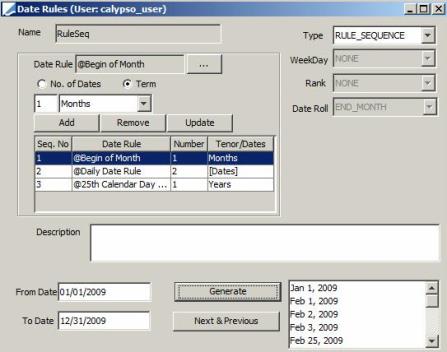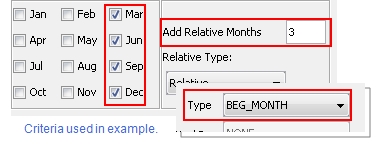Defining Date Rules
Date rules are used throughout the system to generate a schedule of dates based on complex frequencies.
From the Calypso Navigator, navigate to Configuration > Definitions > Date Schedule Definitions > Date Rules (menu action refdata.DateRuleWindow) for defining date rules.
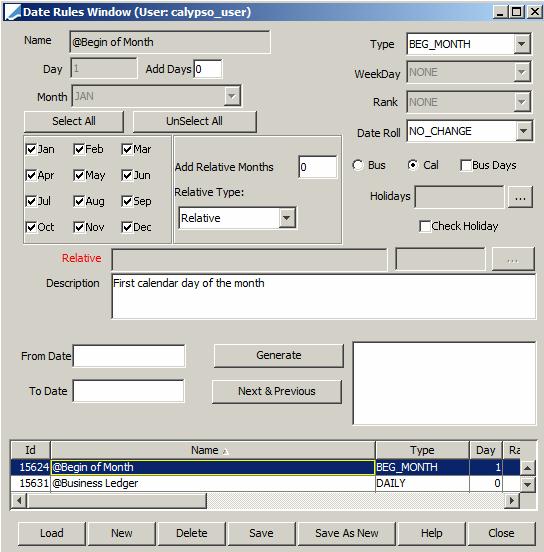
Date Rule window
| » | Date rules are identified by a name throughout the system. Once a date rule is defined, you can enter from and to dates, and click Generate to check that the dates correspond to the dates you want to obtain. |
The general process for generating dates is the following:
| – | The system generates default dates based on the selected type and selected months (for example every first day of the month). |
| – | Then you can add business days or calendar days (depending on the Bus/Cal radio buttons) to the default generated dates (see Add Days below). |
| – | Finally, you can have an additional check that the new date is a business date (see Check Holiday below). If is falls on a holiday, the date will be rolled according to the date roll convention. |
| » | You can implement custom date generators. Refer to the Calypso Developer’s Guide for details. Once a custom generator is implemented, to define the date rule, you must select the CUSTOM type, then save it as the name of your custom generator. So for example, if you have created a custom generator named DateGeneratorMyDateRule, you must save the date rule as MyDateRule. |
1. Creating a Date Rule
Click New to define a date rule, and enter the fields described below.
Then click Save As New to save your changes. You will be prompted to enter a rule name. The new date rule will be added to the list.
Date Rule Fields Details
|
Fields |
Description |
||||||||||||||||||||||||||||||||||||||||||||||||||||||||||||||||||||||||
|---|---|---|---|---|---|---|---|---|---|---|---|---|---|---|---|---|---|---|---|---|---|---|---|---|---|---|---|---|---|---|---|---|---|---|---|---|---|---|---|---|---|---|---|---|---|---|---|---|---|---|---|---|---|---|---|---|---|---|---|---|---|---|---|---|---|---|---|---|---|---|---|---|---|
|
Name |
The name identifies the date rule throughout the system. |
||||||||||||||||||||||||||||||||||||||||||||||||||||||||||||||||||||||||
|
Type |
Select the type of date rule that you want to create.
For example, the rule is defined as "Add 2 Months". If you generate the dates between 03/12/2012 and 07/12/2012, you will obtain "03/12/2012 + 2 months = 05/12/2012" and "05/12/2012 + 2 months = 07/12/2012".
In this example, the dates from "@Begin of Month" are generated for 1 month, then two dates are generated from "@Daily Date Rule", then the dates from "@25th Calendar Day of Month" are generated for 1 year (or until the end of the period). Generated Dates: For 1 month, the beginning of the month: Jan 1, 2009 and Feb 1, 2009 - Then 2 days: Feb 2, 2009 and Feb 3, 2009 - Then the 25th of the month for the rest of the period: Feb 25, 2009, Mar 25, 2009, Apr 25th, 2009, etc.
|
||||||||||||||||||||||||||||||||||||||||||||||||||||||||||||||||||||||||
|
Day |
Enter the day in the month for DAY_FIXED or DAY_MONTH_FIXED. |
||||||||||||||||||||||||||||||||||||||||||||||||||||||||||||||||||||||||
|
Add Days |
Enter a number of days to be added to the default calculated dates. For example, if you enter 2 for BEG_MONTH, the rule will add 2 days to the first day of the month. Select the radio button Bus or Cal to specify whether to add business days or calendar days. You can check the Bus Days checkbox to indicate that, before adding the specified number of days, if the date falls on a holiday, the system uses the specified Date Roll to roll to the following business day. Then the specified number of days are added. |
||||||||||||||||||||||||||||||||||||||||||||||||||||||||||||||||||||||||
|
Month |
Select the month for DAY_MONTH_FIXED. |
||||||||||||||||||||||||||||||||||||||||||||||||||||||||||||||||||||||||
|
Individual Months |
You can check individual months to which the rule applies. You can also click Select All to apply the rules to all months. Click UnSelect All to clear all months. |
||||||||||||||||||||||||||||||||||||||||||||||||||||||||||||||||||||||||
|
Add Relative Months Relative Type |
Add Relative Months - The Add Relative Months field uses the value in the field to add that number of months to the individual months already selected. These months are added relative to selected months and are not static. Relative months depend on the date on which the date schedule is in use (the current day's date, aka, the anchor date) and therefore change over time accordingly. Relative Type - The Relative Type settings create further conditions for the way the anchor date and relative months affect the schedule of dates. Refer to the example below to see how they differ in use. The From Date in the following example refers to the date generated by the Next & Previous button used in testing the date rule. See Testing a Date Rule. This date provides the point of reference described as the anchor date mentioned above.
For the example, the date rule Type is set to BEG_MONTH; selected individual months are Mar, Jun, Sep, and Dec; the Add Relative Months value is 3. January 1st has been made the anchor date to simplify explanation.
Ⓘ [NOTE: Relative Types "Relative" and "Absolute" will both include the From Date (anchor date) in the schedule. Relative Types "Fixed," "Nearest," and "Nearest-Relative," on the other hand, roll to the next date in the sequence and do not include the From Date. When testing the date rule schedule, this becomes apparent after clicking the Next & Previous button, which shows results for the Next Date. For details on testing results for the date rule, see Testing a Date Rule.] |
||||||||||||||||||||||||||||||||||||||||||||||||||||||||||||||||||||||||
|
WeekDay |
Select the day in the week for IMM, WEEKDAY_FIXED, or WEEKLY. |
||||||||||||||||||||||||||||||||||||||||||||||||||||||||||||||||||||||||
|
Rank |
Select the rank of the weekday in the month for IMM, or in the week for WEEKLY: NONE, FIRST, SECOND, THIRD, FOURTH, LAST. |
||||||||||||||||||||||||||||||||||||||||||||||||||||||||||||||||||||||||
|
Date Roll |
Select the date roll convention to roll the dates when "Bus Days" is checked, or when "Check Holidays" is checked. Date Roll conventions are described under Help > Date Roll Conventions. |
||||||||||||||||||||||||||||||||||||||||||||||||||||||||||||||||||||||||
|
Bus Cal |
This only applies if you have populated "Add Days" to indicate whether to add business days or calendar days. |
||||||||||||||||||||||||||||||||||||||||||||||||||||||||||||||||||||||||
| Bus Days |
This only applies if you have populated "Add Days". You can check the Bus Days checkbox to indicate that, before adding the specified number of days, if the date falls on a holiday, the system uses the specified Date Roll to roll to the following business day. Then the specified number of days are added. |
||||||||||||||||||||||||||||||||||||||||||||||||||||||||||||||||||||||||
|
Holidays |
Click... to select holiday calendars to determine holidays when "Add Days" is populated. See "Add Days" for details. |
||||||||||||||||||||||||||||||||||||||||||||||||||||||||||||||||||||||||
|
Check Holiday |
This only applies if you have populated "Add Days". You can check "Check Holiday" when you want to check for holidays (after the calendar days have been added if any). If you check "Check Holiday" the system will make sure that the new date is a business date. It is falls on a holiday, it will be rolled according to the date roll convention. |
||||||||||||||||||||||||||||||||||||||||||||||||||||||||||||||||||||||||
|
Relative |
Only appears when the RELATIVE type has been selected. Click ... to select a relative date rule. The new date rule is based on the relative date rule, with any specified adjustments. For example, on the IMM futures market, trading dates are calculated from delivery dates. As the delivery date in most cases is defined as the 3rd Wednesday of Delivery Month and the last Trading date is 2 business days before Delivery date, you can define a trading rule based on the delivery date with Add days = equals –2 Bus. |
||||||||||||||||||||||||||||||||||||||||||||||||||||||||||||||||||||||||
|
Rules |
Only appears when the DIFFERENCE, UNION or INTERSECTION types have been selected. Click ... to select the date rules part of the difference, union or intersection. |
||||||||||||||||||||||||||||||||||||||||||||||||||||||||||||||||||||||||
|
Description |
Enter a user-defined comment as needed. |
||||||||||||||||||||||||||||||||||||||||||||||||||||||||||||||||||||||||
|
From Date To Date |
In order to verify that the date rule definition is valid, you may generate all dates matching your rule between the From Date and the To Date fields.
|
Sample Usage
Typically, a date rule will be required to generate a schedule.

Sample swap details
2. Testing a Date Rule
| » | Select an existing date rule, and enter from and to dates. |
| » | Then click Generate. The dates generated by the date rule will appear. |
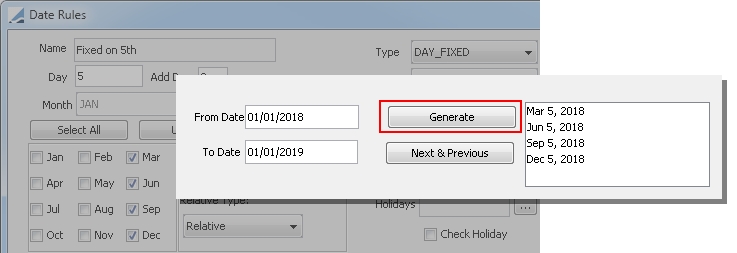
Sample date rule test
You can also click Next & Previous to view the next and the previous dates that the system would generate.

3. Modifying a Date Rule
| » | Select an existing date rule, and modify it as applicable. |
| » | Then click Save to save your changes. |
4. Deleting a Date Rule
| » | Click Delete. You will be prompted to select a date rule. |
Note that if the date rule is in use, you will not be able to delete it.
5. Out-of-the-Box Custom Date Generators
To define the date rule, you must select the CUSTOM type, and then save it as the name of the custom generator, as in the example below.
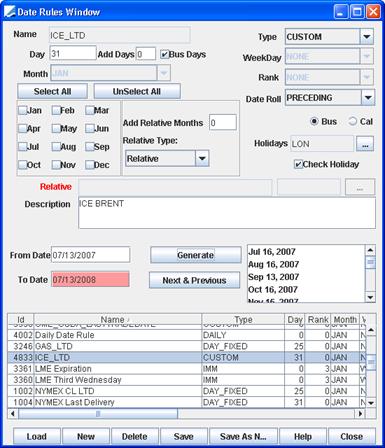
Sample custom date generator
Calypso provides the following custom date generators out-of-the-box.
|
Generator / Date Rule Name |
Description |
|---|---|
|
Aluminum |
Daily from cash to 3 months (first prompt date two working days from cash). Then every Wednesday from 3 months to 6 months. Then every third Wednesday from 7 months out to 27 months forward. Define the holidays in the date rule. |
|
CBOT_WHEAT_OPTION_EXPIRY |
Pre-generated list of option expiry dates through 2040 for CBOT Wheat standard option contracts. |
|
CBOT_WHEAT_SERIAL_OPTION_EXPIRY |
Pre-generated list of option expiry dates through 2040 for CBOT Wheat serial option contracts. |
|
CMEFeederCattle |
Pre-generated list of last trading dates for CME Feeder Cattle Futures Contract. |
|
CME_USDA_LASTTRADEDATE |
Pre-generated list of last trading dates for CME USDA. |
|
COMEX_JUNE_DEC_OPTION_EXPIRY |
Expiration occurs on the fourth business day prior to the first day of June and December. If the expiration falls on a Friday or immediately prior to an Exchange holiday, expiration will occur on the previous business day. Pre-generated list of option expiry dates through 2040. |
|
COMEX_MONTHLY_OPTION_EXPIRY |
Expiration occurs on the fourth business day prior to the first day of each month. If the expiration falls on a Friday or immediately prior to an Exchange holiday, expiration will occur on the previous business day. Pre-generated list of option expiry dates through 2040. |
|
COMEX_GOLD_MID_OPTION_EXPIRY |
Expiration occurs on the fourth business day prior to the first day of February, April, June, August, October, and December. If the expiration falls on a Friday or immediately prior to an Exchange holiday, expiration will occur on the previous business day. Pre-generated list of option expiry dates through 2040. |
|
COMEX_SILVER_MID_OPTION_EXPIRY |
Expiration occurs on the fourth business day prior to the first day of March, May, July, September, and December. If the expiration falls on a Friday or immediately prior to an Exchange holiday, expiration will occur on the previous business day. Pre-generated list of option expiry dates through 2040. |
|
ICE_ECX_LTD |
Pre-generated list of last trading dates for the ICE Futures CFI Futures Contract. |
|
ICE_LTD |
Pre-generated list of last trading dates for the ICE Brent Crude futures contract. |
|
ICE_LTD_FUTURE_OPTIONS |
Pre-generated list of last trading dates for the ICE Brent Futures Options. |
|
IMMCombined |
Generates the expiry dates on CME Quarter and Serial Eurodollar Future Option contracts. |
| IMMNZD | Generates expiration dates on NZD 90D Bank Bill Futures. The expiration dates fall on the first Wednesday after the 9th day of March, June, September, December. If the expiration date falls on an exchange holiday (specified by the selected holidays calendar configured on the Date Rule), the date is rolled using the FOLLOWING roll method to the next good business day. |
Ⓘ [NOTE: The four COMEX rules can be used together in a RULE_SEQUENCE to generate the expiration dates for COMEX Precious Metal Option Expirations. Following is an example]
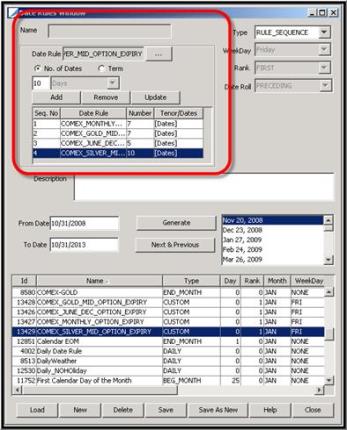
|
Generated Dates: 11/20/2008 12/23/2008 01/27/2009 02/24/2009 03/26/2009 04/27/2009 05/26/2009 07/28/2009 09/24/2009 11/23/2009 01/26/2010 03/25/2010 05/25/2010 07/27/2010 11/23/2010 05/25/2011 11/22/2011 05/24/2012 11/27/2012 02/25/2013 04/25/2013 06/25/2013 08/27/2013 |
Sample RULE_SEQUENCE
6. Custom Date Rule Tenor Shortcut Window
The Custom Date Rule Tenor Shortcut window allows you to assign a shortcut key to a pre-existing date rule so that a custom date rule based tenor can be used to quickly populate compatible date fields using the date rule.
From the Calypso Navigator, point to Configuration > Definitions > Custom Tenors (menu action refdata.CustomTenorShortcutWindow) and open the window to begin creating a custom date rule tenor shortcut.
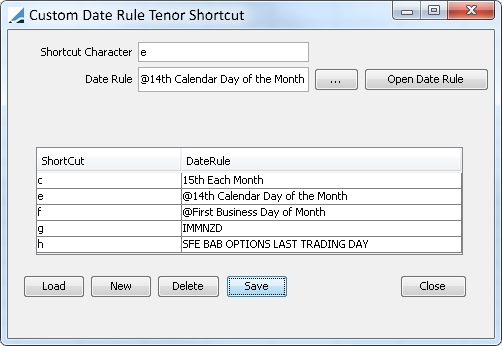
Example of Tenor Shortcut window with saved shortcut keys associated with date rules.
6.1 Access Permissions
The following access permission functions are specific to the Custom Date Rule Tenor Shortcut window.
ViewCustomDateRuleTenors
Provides permission to open/view the Custom Date Rule Tenor Shortcuts window.
RemoveCustomDateRuleTenors
Provides permission to delete existing custom tenor configurations.
AddModifyCustomDateRuleTenors
Provides permission to create new or modify existing custom tenor configurations.
 For details on assigning Access Permissions, see Access Permissions in Calypso User Security documentation.
For details on assigning Access Permissions, see Access Permissions in Calypso User Security documentation.
6.2 Creating a Shortcut
| » | Click New to clear Shortcut Character and Date Rule fields and prepare for adding a new shortcut. |
| » | In the Shortcut Character field, enter any letter a through z that is not already used by the system for shortcuts. |
Exceptions are y, m, w, d, b, and i, which are used as shortcuts for year, month, week, day, business days, and IMM tenors.
| » | Click ... beside the Date Rule field to open the Select DateRule window, where you can select a date rule from all of those available in the system. Use the "Search text" field to filter date rules by text that begins the name of the date rule. |
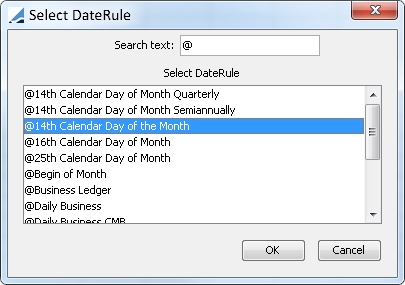
After highlighting a date rule in the list, click OK to close the Select DateRule window and populate the Date Rule field.
| » | You can click Open Date Rule to open the Date Rule window for the rule that is populated in the Date Rule field. |
| » | Click Save to save the shortcut. It then appears in the table of shortcuts and associated date rules in the bottom portion of the window. |
| » | You can select a row in this table and click Delete to remove the shortcut. |
Ⓘ [NOTE: Manual date rules and rules that generate only one date are not supported.]
6.3 Using Custom Date Rule Tenor Shortcuts
The Custom Date Rule Tenor Shortcuts rely on an anchor date as a starting point for generating a date based on the date rule schedule. When using a shortcut for populating a Start Date, the shortcut uses the Valuation Date as the anchor. When using a shortcut for the End Date, the Start Date is the anchor.
To apply a shortcut, enter an integer in the date field followed by the letter associated with the date rule.
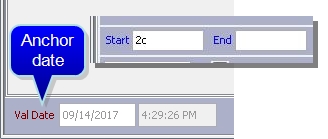
Then press Enter. The shortcut key applies the date rule and the integer determines how far out the date is and populates the date field accordingly.

The Custom Date Rule Tenor Shortcut feature is available in the following products and fields.
| • | Swap Trade Window – Start Date, End Date |
| • | FRA Trade Window – Start Date, End Date |
| • | Swaption Trade Window – Underlying Swap Start Date, Underlying Swap End Date |
| • | Pricing Sheet strategies: Swap, FRA, Cap, Fixed Rate, Floating Rate – Start Date, End Date |
| • | Front Office Workstation components: Swap Pricer, Line Swap Pricer – Start Date, End Date |
